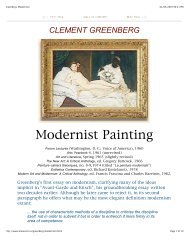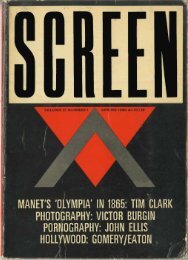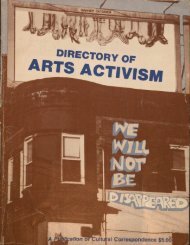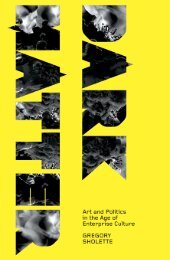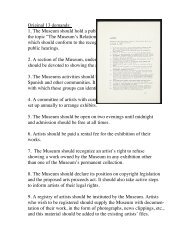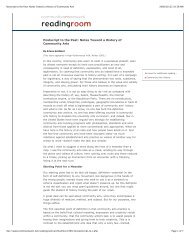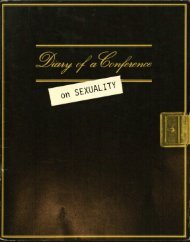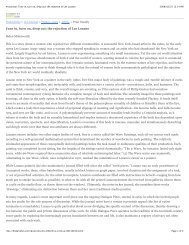A COLLECTOGRAPHY OF PAD/D - Gregory Sholette
A COLLECTOGRAPHY OF PAD/D - Gregory Sholette
A COLLECTOGRAPHY OF PAD/D - Gregory Sholette
You also want an ePaper? Increase the reach of your titles
YUMPU automatically turns print PDFs into web optimized ePapers that Google loves.
A<br />
<strong>COLLECTOGRAPHY</strong><br />
<strong>OF</strong> <strong>PAD</strong>/D<br />
Political Art Documentation and Distribution:<br />
A 1980’s Activist Art and Networking<br />
Collective<br />
Members of the Not For Sale<br />
Committee of <strong>PAD</strong>/D (L - R)<br />
<strong>Gregory</strong> <strong>Sholette</strong>, Michael Anderson,<br />
Janet Koenig, Ed Eisenberg, 1984.<br />
GREGORY SHOLETTE<br />
Our goal is to provide artists with an organized relationship<br />
to society, to demonstrate the political effectiveness of<br />
image making, and to provide a framework within which<br />
progressive artists can discuss and develop alternatives to<br />
the mainstream art system. —<strong>PAD</strong>/D Mission Statement<br />
I. From archive to organization in the course of one<br />
evening<br />
What started as a straightforward call to establish an archive of<br />
politically committed art wound up instigating an ambitious<br />
new artistʼs collective. A decade before the emergence of the<br />
world wide web and prior to the introduction of the personal computer,<br />
one organization of artists and activists sought to produce a networked,<br />
This text is being made available for scholarly purposes only. You are free to<br />
copy an distribute it, but never for commercial profit. Please attribute the author whenever<br />
quoted or cited. All illustrations are included here solely for educational purposes.<br />
This essay first appeared on the now defunct Groups and Spaces e-zine website. The author<br />
extends his appreciation to Lucy R. Lippard, Janet Koenig, Herb Perr and Brett Bloom for<br />
their feedback and assistance on this essay.
2 GREGORY SHOLETTE<br />
parallel arena in which to nurture, theorize, display and distribute creative<br />
practices opposed to, or simply desperate to be something other<br />
than, capitalist culture. It began with a meeting called together February<br />
24th, 1980 by the art critic Lucy R. Lippard. The call itself had been<br />
printed on the flip side of an invitation for an exhibition she organized<br />
at Artists Space featuring the “many good, socially active artists no one<br />
heard of.” By using the mailed invite as an organizing tool, Lippard<br />
had also transgressed her own, presumed curatorial disengagement, a<br />
point I return to below. Nevertheless, on this winterʼs evening, a group<br />
of fifty or so artists, writers and veteran political activists eagerly answered<br />
her call. Lippardʼs planned agenda was to explore ways of archiving<br />
her swelling collection of documents about art with political<br />
intent. The meeting took place at Printed Matter Book Store that was<br />
then located on Lispenard Street in Downtown Manhattan. Lippardʼs<br />
plea to not found another organization was quickly disregarded and<br />
the rest of the story forms a chapter in the unknown history of collective,<br />
activist art gradually being excavated by a new generation of<br />
historians.<br />
I attended the meeting in search of an intellectual and creative community<br />
that held similar beliefs about the place of art within a broader<br />
movement of progressive, social transformation. Having recently<br />
graduated from The Cooper Union School of Art where I studied with<br />
Hans Haacke, what I discovered that evening was a group of cultural<br />
workers who, rather than merely discussing their own art or career,<br />
instead eagerly debated issues of racism and sexism in the US, ending<br />
apartheid in South Africa, and opposing the stationing of US “tactical”<br />
nuclear weapons in Europe. What I did not know then however was the<br />
degree to which this encounter would alter the direction of my career<br />
as well as my life. Before the end of that February evening a new, artistsʼ<br />
collective had been conceived, named and given a mission.<br />
Present that evening was Clive Philpot, then the Director of the<br />
Museum of Modern Art Library. Philpot christened the new group Political<br />
Art Documentation or <strong>PAD</strong>. But in the months ahead the new<br />
group experienced a minor split within its ranks. Contemplating the<br />
many thankless chores required to service other artists, including archiving,<br />
cataloging and cross-referencing their work, the membership<br />
expressed a strong desire to produce its own, collectively authored art.<br />
Sometime later in 1980 or early 81 therefore the ʻDʼ for Distribution<br />
was adopted by the group, thus transforming <strong>PAD</strong> into <strong>PAD</strong>/D. In the<br />
immodest language typical of the period the groupʼs mission sought<br />
to,<br />
...Build an international, grass roots network of artist/<br />
activists who will support with their talents and their<br />
political energies the liberation and self-determination of all<br />
disenfranchised peoples.(<strong>PAD</strong>/D. 1st Issue. New York City,<br />
issue no.1, Feb. 1981.)
<strong>COLLECTOGRAPHY</strong> <strong>OF</strong> <strong>PAD</strong>/D 3<br />
Within a year of its founding <strong>PAD</strong>/D was making art as well as<br />
archiving. It was also programming public events, networking with<br />
other organizations, and publishing its own newsletter named simply<br />
1st Issue. (And soon renamed Upfront after it became apparent that<br />
a many issues of 1st Issue would be extremely confounding.) Along<br />
with Upfront, the group also published a one-page calendar of progressive,<br />
cultural events in the NYC area called Red Letter Days. In sum,<br />
it would not be unfair to describe the driving force behind this frenetic,<br />
multileveled activity as a desire to unilaterally reconstruct the entire,<br />
corrupted world of bourgeois art from the bottom up. As the group<br />
stated in its first newsletter:<br />
<strong>PAD</strong> [/D] can not serve as a means of advancement within<br />
the art world structure of museums and galleries. Rather, we<br />
have to develop new forms of distribution economy as well<br />
as art... (Ibid.)<br />
To achieve this objective, the group began developing plans for an<br />
organization of even larger size and complexity: a national or perhaps<br />
even international network of like-minded activist artists working in<br />
consort with non-art, progressive activists. If <strong>PAD</strong>/Dʼs immediate goal<br />
was to organize a highly fractured, post-68 counter-culture, the groupʼs<br />
larger vision sought to bring into being a bona-fide counter-hegemonic<br />
or oppositional public sphere. Woven from equal parts recovered genealogies<br />
(from the <strong>PAD</strong>/D archival materials) and politically sympathetic<br />
exhibition outlets (university galleries, labor unions, community<br />
centers, even church halls), this longed-for, counter-hegemony was,<br />
more than anything else, the feature that set <strong>PAD</strong>/D apart from other,<br />
self-organized, art collectives then or since.<br />
The high stakes <strong>PAD</strong>/D placed on networking artists with activists<br />
is instantly apparent if one examines the diverse topics touched-upon<br />
in its monthly, public dialogue series known as Second Sundays. First<br />
held at Printed Matter Books and later moved to the Franklin Furnace a<br />
few blocks away, a sample list of Second Sunday evenings from 1981<br />
includes: The History of Abortion Rights; Civil Liberties and Domestic<br />
Surveillance; War Tax Evasion; Unauthorized Art in Public Spaces;<br />
Hispanic Culture and Struggle and Art and Ecological Issues. (1st<br />
Issue. no. 2, May-June 81). In addition, the groupʼs public platform<br />
presented issues related to Art Education, Native American art and<br />
one evening hosted by Lucy Lippard and Jerry Kearns that celebrated<br />
what they described as the culture of “The Street.” As much as these<br />
programs sought to connect artists with progressive activists however,<br />
they were also intended to prove to activists the political value of art.<br />
Today, from Seattle to Genoa, from to New York to London, the cultural<br />
politics visible in the counter-globalization movement, as well as<br />
the emerging anti-war movement, offer strong evidence that <strong>PAD</strong>/Dʼs<br />
strategy was in fact a forward-looking one.<br />
On February 26th, 1982, two years and two days from its inaugural<br />
meeting at Printed Matter, <strong>PAD</strong>/D hosted a sizable gathering of<br />
Back Page of 1st Issue, <strong>PAD</strong>/D’s first<br />
newsletter, Feb. 1981.<br />
<strong>PAD</strong>/D flyer announcing an<br />
upcoming presentation by the<br />
feminist art collective Carnival<br />
Knowledge in 1984.
4 GREGORY SHOLETTE<br />
Exhibition <strong>PAD</strong>/D organized in<br />
Chicago displaying a range of<br />
“demonstration art” for public use.<br />
activists and artists at the Bread & Roses, 1199 Health and Hospital<br />
Workers Union Hall on West 43rd Street in New York City. Timed to<br />
conflict with the College Art Associationʼs Conference, the “February<br />
26th Movement” as it was called brought together dozens of organizations<br />
and individuals ranging from Los Angeles-based, Social and<br />
Public Art Resources or SPARC to local participants including Group<br />
Material. It also featured presentations by several energetic if comparatively<br />
politically ambiguous alternative spaces including, Fashion<br />
Moda from the Bronx and ABC No Rio from the Lower East Side of<br />
Manhattan. As <strong>PAD</strong>/D member Keith Christensen put it, “I went to<br />
the February 26th conference after learning about it from the Village<br />
Voice and found a whole world of alternative paths for an artist to<br />
take. It changed my life because I learned how to integrate my political<br />
and artistic sensibilities.” Christensen soon find himself working with<br />
<strong>PAD</strong>/D to re-design Upfront. And while the newsletter would indeed<br />
become a platform for the dissemination of activist culture, the larger<br />
goal of a sustainable, progressive cultural network eluded the group.<br />
Yet if the groupʼs overconfidence and sense of political mission led it<br />
at times to outstrip its own resources, <strong>PAD</strong>/Dʼs collective, organizational<br />
verve nevertheless out-performed many other, more traditionally<br />
structured and better funded cultural institutions, including many<br />
“alternative spaces.”<br />
Perhaps <strong>PAD</strong>/Dʼs success at organizing artists, a denomination<br />
typically antagonistic to administrative rules and discipline, appears<br />
somewhat less remarkable if one takes into account the background of<br />
the groupʼs initial membership between 1980 and1982. Lucy R. Lippard<br />
for example was not only a noted arts writer, but was also an<br />
activist and accomplished organizer who participated in the founding<br />
of the feminist art collective Heresies, Ad-Hoc Women Artists, and<br />
Printed Matter Books, the groupʼs initial home. Perhaps as many as<br />
two thirds of <strong>PAD</strong>/Dʼs early membership brought with them previous<br />
experience working with other cultural collectives, institutions or programs.<br />
Along with the aforementioned Clive Philpot of MoMA, <strong>PAD</strong>/<br />
Ds organizational assets included veterans of the Art Workers Coalition<br />
or AWC, Fluxus, Cultural Correspondence, Artists Meeting for Cultural<br />
Change or AMCC, Collaborative Projects or Colab, Red-Herring,<br />
Amiri Brarakaʼs Anti-Imperialist Cultural Union; The Neighborhood<br />
Arts Programs National Organizing Committee or NAPNOC, (later<br />
renamed the Alliance for Cultural Democracy or ACD); The Womenʼs<br />
Building and Angry Arts. In addition, several <strong>PAD</strong>/D members simultaneously<br />
belonged to other; recently formed artistsʼ collectives such<br />
as Group Material, World War 3 Illustrated, and Carnival Knowledge.<br />
(A partial list of the <strong>PAD</strong>/D membership and their affiliations appears<br />
at the end of the essay.)<br />
Nevertheless, in order to accomplish so much in such a short<br />
period of time - essentially between 1980 and 1985 in terms of the<br />
groupʼs most significant work - the members of <strong>PAD</strong>/D devoted many
<strong>COLLECTOGRAPHY</strong> <strong>OF</strong> <strong>PAD</strong>/D 5<br />
hours of in-kind, unpaid labor. What actual cash revenue<br />
was raised went to cover the rent, publication<br />
costs and but never labor. And money did come, in<br />
the form of donations from sympathetic artists including<br />
Hans Haacke, Leon Golub, Jenny Holzer, Nancy<br />
Spero; Barbara Kruger and even on one occasion Julian<br />
Schnabel. Funds were also generated through the<br />
call for modest dues as well as through benefit events,<br />
including one that I organized at Club 57 on St. Marks<br />
Place with very mixed success that featured the late<br />
artist David Wojnarowicz and his band Three Teens<br />
Kill Four.<br />
II Structure<br />
A snapshot of how the group initially structured itself to achieve its<br />
ambitious mission is visible from an internal memo dated October<br />
26th, 1980 entitled; “P.A.D. Work groups.” The typewritten agenda<br />
lists twenty-four people and phone numbers. Each is assigned to one<br />
or more of three working groups that include:<br />
Group I: P.R. Community Organizations, Cross-country outreach<br />
via newsletter and posters.<br />
Group II: The Physical Archives and its organization; the ninth<br />
street office and building Archival shows.<br />
Group III: Exhibitions in public places; outreach to political organizations.<br />
(Original memo is in the Lippard Papers at the Archives of American<br />
Art, Smithsonian Institute.)<br />
Originally headquartered in a former school building on the eastern<br />
side of Tompkins Square Park called El Bohio, <strong>PAD</strong>/D later moved<br />
to larger quarters and into the building owned and operated by the A.<br />
J. Muste Foundation at the corner of Lafayette and Bleecker Streets.<br />
Dubbed the “peace” building because it also housed the pacifist organization<br />
The War Resisters League, the groups other neighbors included<br />
Paper Tiger Television and CISPES, the Committee in Solidarity<br />
with the People of El Salvador. Initially, membership consisted of<br />
anyone who happened to be present at any given <strong>PAD</strong>/D meeting. This<br />
soon became untenable when it became apparent that one, highly vocal<br />
newcomer could sidetrack an entire project already invested with<br />
weeks of work. Membership was soon reformulated to include only<br />
those who already showed a commitment to the group by their involvement<br />
in specific, <strong>PAD</strong>/D projects or Work Group. The organizational<br />
structure continued to develop. Sometime prior to February of 1982 a<br />
Steering Committee made up of one person from each work group was<br />
established. Flow-charts were drawn-up and debates held about how to<br />
vote: for example, does the group pass a resolution based on a majority<br />
rule, or does it seek total consensus? (In the end, the group adopted a<br />
three-fourths voting rule.) Before long, a somewhat more centralized<br />
“Image War on the Pentagon,” <strong>PAD</strong>/<br />
D’s contribution to a massive street<br />
demonstration in Washington DC<br />
during the summer of 1983.
6 GREGORY SHOLETTE<br />
and rule bound organization emerged. And in order to allow donors<br />
to deduct financial contributions to <strong>PAD</strong>/D as well as for the group to<br />
attract grant money the appropriate legal paperwork was filed making<br />
<strong>PAD</strong>/D both a charitable organization and a not for profit, 501 (C)<br />
3 corporation. It was nevertheless a great surprise to group members<br />
when <strong>PAD</strong>/D was in fact selected by a peer review panel at the National<br />
Endowment for the Arts for a modest grant to help with the cost<br />
of producing Upfront. However, Ronald Reaganʼs newly appointed<br />
NEA Chairman, Frank Hodsoll quickly made an unprecedented, public<br />
denunciation of the review panelʼs choice that had also included<br />
an award to the Heresies journal. The grant was “withdrawn.” This<br />
occurrence, together with the de-funding of Franklin Furnace artistʼs<br />
space by the NEA following an exhibition by Carnival Knowledge at<br />
about the same time, predated the far more publicized “culture wars”<br />
of the early 1990s. I can not help speculate that because these events<br />
involved art “collectives,” rather than individuals, the significance of<br />
this censorship appeared lass newsworthy and has faded from view. 1<br />
<strong>PAD</strong>/D did indeed function in a strongly collective manner. That<br />
does not alter the fact that the contribution of specific individuals<br />
uniquely shaped the mission and structure of the group. Certainly, Barbara<br />
Moore and Mimi Smith, two members who remained singularly<br />
devoted to the <strong>PAD</strong>/D Archives, hold a special position in this respect.<br />
It was the contribution of Lucy R. Lippard however that, more than<br />
any other <strong>PAD</strong>/D member, shaped the overall character of the group.<br />
Lucy R. Lippard<br />
III. Lucy Lippard & <strong>PAD</strong>/D<br />
Lippardʼs book chronicling the formation of Conceptual Art, Six years:<br />
the dematerialization of the art object, functioned as a “new testament”<br />
for a “post-Greenbergian” generation of artists who would reject the<br />
cool detachment of formalism. Charismatic and gifted with a ceaseless<br />
energy, Lippard was nevertheless a consensus builder. To myself and<br />
many others she also exemplified what cultural theorist Walter Benjamin<br />
termed the Author as Producer, that is, a bourgeois writer who<br />
rejects the “proper” journalistic position of distanced neutrality in favor<br />
of active partisanship with a struggle for social change. Needless<br />
to say, such overt blurring of roles between critic and activist, observer<br />
and participant is anathema to the imagined, aesthetic neutrality of established<br />
art history and art criticism and no doubt led to her being fired<br />
from the Village Voice in 1985 after four years. But it was Lippardʼs<br />
conspicuous support for art with political content that helped lay the<br />
foundation for the emergence of <strong>PAD</strong>/D. As word spread about her<br />
interests, initially via another postcard invitation for an exhibition she<br />
organized of Rasheed Araeenʼs work in London, the writer became a<br />
magnet for the highly dispersed and largely invisible multitude of artists<br />
who sought to combine their work with political and social activism.<br />
Inundated with slides, posters, flyers, manifestos and related materials<br />
Lippard understood that the artists who sent her documentation
<strong>COLLECTOGRAPHY</strong> <strong>OF</strong> <strong>PAD</strong>/D 7<br />
of their work were not only “invisible” to the art establishment, they<br />
were also unseen and isolated from each other as well. Logically, the<br />
concept of an active archive that could reverse this invisibility emerged<br />
out of these observations.<br />
If Lippardʼs archival assets served as the growth medium for incubating<br />
<strong>PAD</strong>/D, it was the writerʼs presence at the Village Voice, a hip,<br />
weekly newspaper featuring progressive culture and journalism, which<br />
provided the heat. Her weekly column thrust into view not so much the<br />
group itself, but its mission of socially committed art activism. While<br />
Lippard provided outward visibility, it was the artist and activist Jerry<br />
Kearns who most strongly shaped the internal, administrative and political<br />
dimensions of the group. Kearns, humorously known within the<br />
group as the “commissar,” came to <strong>PAD</strong>/D soon after it started while<br />
he was still active in Amiri Barakaʼs Anti-Imperialist Cultural Union<br />
as well as the Black United Front. A white, working class southerner,<br />
Kearns had also been part of an Art & Language/Fox Magazine splinter<br />
group known as Red Herring. In the pages of the two publications<br />
Red Herring produced the group called on artists to “learn from the<br />
masses,” and develop a “proletarian culture” that was specific to North<br />
America, yet influenced by Mao Zedongʼs Cultural Revolution. This<br />
analysis led Red Herring to virtually reject the art world. And while no<br />
official political line ever existed within <strong>PAD</strong>/D, this late, New Left<br />
social analysis certainly flavored the discourse of the group, especially<br />
during the first two years of 1980 to1982. At the same time, one can<br />
see the formation of internal, disciplinary structures that more closely<br />
resemble a political party than it did other, organized artists collectives<br />
including most notably Group Material, <strong>PAD</strong>/Ds closest, artistic “relative”<br />
so to speak. Meanwhile, Lippard and Kearns also collaborated<br />
on lectures and writings as well as a performance piece entitled “My<br />
Place, Your Place, Our Place,” in which they examined the genesis of<br />
their own political identities, a strong indication that Lippardʼs feminist<br />
politics was affecting and changing more orthodox ideological<br />
leanings.<br />
IV. Four <strong>PAD</strong>/D Public Actions<br />
Largely unknown are the numerous collective art projects <strong>PAD</strong>/D produced<br />
during its six-year tenure. Typically edged in a critical yet ironic<br />
humor, these primarily public works avoid what Fredric Jameson<br />
calls the “flattened affect” of post-modernist pastiche. What follows<br />
are four of <strong>PAD</strong>/Dʼs projects including “Death and Taxes”, “No More<br />
Witch-Hunts”, “Image War on the Pentagon” and “Not For Sale: A<br />
Project Against Gentrification.” Notably, each one privileged public<br />
performance and ephemeral work over art objects.<br />
“DEATH AND TAXES,” APRIL, 1981:
8 GREGORY SHOLETTE<br />
Micki McGee’s individual taxpayer<br />
form intervention for <strong>PAD</strong>/D’s<br />
Death andTaxes, project at banks<br />
and libraries in various locations of<br />
NYC, 1981.<br />
“Death &Taxes” (D&T) began as an open invitation for artists anywhere<br />
in NYC to produce public works protesting the use of federal taxes for<br />
military instead of social programs. Artists were asked to document<br />
what they did and send this to Gallery 345, a small not for profit space<br />
located just downstairs from the <strong>PAD</strong>/D office on Lafayette Street. Approximately<br />
twenty artists responded to the call, placing their work<br />
in subways, armories, public toilets and banks. Examples of works<br />
produced for “Death and Taxes” include one thousand IRS 1040A tax<br />
forms gathered up, “altered” and then put them back into circulation<br />
at banks and Post Offices in downtown Manhattan by Micki McGee.<br />
The artist printed over top of the government document her own public<br />
service agit-prop art that read in part: “53 ¢ of every tax dollar goes<br />
to military and defense budgets... over half your tax dollar... “. The<br />
boxes normally used for reporting income were filled-in already with<br />
graphic images of a fighter jet dropping bombs and a soldier marching.<br />
On a second page another line of type informs the citizen, “How would<br />
your life be different if your taxes went to... “ Followed by a series of<br />
choices that include “public transportation instead of aircraft carriers”<br />
and “the arts and humanities instead of war debts.” The latter text was<br />
punctuated by a wheel chair bound figure.<br />
Other D&T projects included anti-military propaganda printed<br />
directly onto dollar bills that were then re-circulated; Lynn Hughʼs<br />
graphic stickers attached to public pay-phones alerting the caller that<br />
the 2% federal tax on telephone calls goes to the military; and Alain<br />
Resnais film, Hiroshima Mon Amour projected onto the 26th street<br />
armory by Tim Rollins from his apartment located across the street.<br />
Rollins describes reactions as ranging from “... sidewalk cheers to rotten<br />
fruit thrown at the window.” And <strong>PAD</strong>/D member Michael Anderson<br />
was arrested after tossing a fabricated, human “dummy” onto<br />
the bayonet of a World War One memorial at another armory location.<br />
After spending a night in prison, Anderson later appeared in Brooklyn<br />
Criminal Court and was discharged.<br />
These informational interventions were joined by a fifty-foot high<br />
T-Rex skeleton made of pink-vinyl sewn to camouflage netting labeled<br />
“Canʼt Afford to Live? Too Alive to Die?” Conceived by <strong>PAD</strong>/D artists<br />
team of Pitrone and Masaryk, “Skeletal Estates” was located in an<br />
abandoned city lot on the Lower East Side of Manhattan. Passersby<br />
were asked to invest in, “the very best in underground living” and offered<br />
“fool-proof protection from “intelligent” missiles as well as Con<br />
Ed and NY telephone.” Anne Pitrone was herself the instigator of the<br />
D&T project first proposing it during one of the first <strong>PAD</strong>/D meetings.<br />
(Pitrone soon co-founded the feminist art collective Carnival Knowledge<br />
that used circus posters and a vernacular art approach to promote<br />
womenʼs sexuality as well as to protest attacks on reproductive rights<br />
and sexual freedom.)<br />
“IMAGE WAR ON THE PENTAGON,” 1981:
<strong>COLLECTOGRAPHY</strong> <strong>OF</strong> <strong>PAD</strong>/D 9<br />
Image War consisted of dozens of cardboard<br />
picket signs carried along by<br />
<strong>PAD</strong>/D members during a demonstration<br />
in Washington DC on May 3rd of<br />
1981. On one side of these portable<br />
signs wordless, black and white cartoons<br />
revealed images of bombs, generals<br />
and rifles each crossed out with<br />
a dramatic red ʻXʼ. On the flip side of<br />
these placards were colorful images<br />
of investments public money could be<br />
used for, including: a loaf of bread, a<br />
glass of milk, a hammer, and a pair of<br />
human hands, one white and one black,<br />
clasped together. Fabricated in the studio<br />
of <strong>PAD</strong>/D member Mike Glier, Image War was designed for use in<br />
the massive march on the pentagon organized by the Peopleʼs Antiwar<br />
Mobilization that drew over 100,000 people to protest budget cuts and<br />
US involvement in El Salvador and Nicaragua.<br />
“NO MORE WITCH HUNTS,” 1981:<br />
In 1981 the Reagan administration passed new and sweeping anti-terrorist<br />
laws giving the government expanded powers of surveillance<br />
over U.S. citizens. Many understood these so-called anti-terrorist laws<br />
as a thinly disguised legal justification for spying on domestic supporters<br />
of the FMLN (Farabundo Marti National Liberation), a Salvadorian-based<br />
insurrectionary organization opposed to the U.S.-backed<br />
regime of Jose Napoleon Duarte. “No More Witch Hunts” brought together<br />
religious activists, a local progressive union, legal activists, and<br />
artists. Group Material members performed a mocking, military-influenced<br />
disco dance outfitted in hybrid “uniforms” that grafted together<br />
standard General Issue camouflage with the bright red colors of the<br />
FMLN. Such reflexive and playful use of visual signifiers marked the<br />
increasing experimentation and confidence of a new “political art” that<br />
was consciously distancing itself from the banners and murals of the<br />
past.<br />
“NOT FOR SALE: A PROJECT AGAINST DISPLACEMENT,” 1983 & 1984:<br />
One of the more ambitious projects the group sponsored grew out of a<br />
reading started in 1981 by memberʼs Jim Murray , Michael Anderson<br />
and myself. For a year, the <strong>PAD</strong>/D Reading Group met to discuss essays<br />
by Bertolt Brecht, Theodore Adorno, Herbert Marcuse, George<br />
Lukacs as well as C.L.R. James and Antonio Negri. Eventually, the<br />
group arrived at a point of frustration with theory apart from practice.<br />
The outcome was a project about the encroaching gentrification of the<br />
Lower East Side, the neighborhood where many of the <strong>PAD</strong>/D Reading<br />
Group members resided. The transformation from a reading group
10 GREGORY SHOLETTE<br />
to an activist group was completed with the choosing of a new identity:<br />
the <strong>PAD</strong>/D, Not For Sale Committee: as in The Lower East Side is not<br />
for sale.<br />
The first Not For Sale (NFS) project was housed in El Bohio, the<br />
same community center that “<strong>PAD</strong>” was initially headquartered in<br />
four years earlier. With a small stipend from the parent group, the NFS<br />
Committee constructed temporary walls and installed a massive exhibition<br />
of two hundred art works. Punk bands, guerrilla theater and<br />
activist rabble-rousers accompanied the opening while throughout the<br />
night, teams of stencil artists took to the streets armed with spray paint<br />
and anti-gentrification imagery. Additional video and cabaret presentations<br />
took place at the Millennium Film Theater and neighborhood<br />
“art bars” including the Wow Cafe and Limbo Lounge. Most of the<br />
artistic entries however were disappointingly unrelated to the issue of<br />
economic and cultural displacement and some venues and their audience<br />
belonged to the same East Village Art Scene that many of us<br />
understood to be part of the process of gentrification itself. When New<br />
York Times arts reviewer Grace Glueck included news of our event in<br />
a piece entitled Pioneering in New Territories, needless to say we were<br />
dismayed (See: The New York Times: June 26, 1983.) As <strong>PAD</strong>/D: NFS<br />
member Janet Koenig stated: the Lower East Side was becoming Off-<br />
Off West Broadway.<br />
In the months that followed the NFS Committee reflected on the<br />
contradictions the exhibition had generated. We re-thought our strategy<br />
and decided to produce a more tactical and flexible project for the<br />
coming year. The new project entitled: “Art for the Evicted: A Project<br />
Against Displacement,” began as a call for artists to produce twenty<br />
copies of an anti-gentrification poster that the NFS Committee pledged<br />
to paste and re-paste in neighborhood streets during the coming months.<br />
The group then overlaid still another layer of critique by selecting four<br />
outdoor locations in which to focus the poster campaign while at the<br />
same time christening these “street galleries” with fictional appellations<br />
directly mocking the East Village Art Scene itself. The four, ersatz<br />
galleries included: The Discount Salon, Another Gallery, The Leona<br />
Helmsley Gallery that was located on a derelict building overlooking<br />
Tompkins Square Park that the Helmsleys later turned into million dollar<br />
condos, and most prophetically The Guggenheim Downtown. The<br />
Later was sited at Avenue A and 10th Street long before Thomas Krens<br />
opened a branch of the Guggenheim museum in SoHo. The group also<br />
produced its own exhibition poster. Silk-screened at the Lower East<br />
Side Print Shop it was designed by <strong>PAD</strong>/D NFS member Janet Koenig<br />
in collaboration with the entire group and depicted a beat-up suitcase<br />
stamped with four travel stickers, one for each, fictive NFS street gallery.<br />
For example, The Guggenheim Downtown sported a logo of a<br />
thick machine screw turned on its head, Another Gallery was rendered<br />
in graffiti style and the Leona Helmsley Gallery was elegant, befitting<br />
the “queen of mean” who had not yet served time for tax evasion.
<strong>COLLECTOGRAPHY</strong> <strong>OF</strong> <strong>PAD</strong>/D 11<br />
The second NFS project opened at The Guggenheim<br />
Downtown on Saturday April 28th, 1984 and included<br />
local housing activists urging passersby to join the<br />
struggle against displacement. As promised, the NFS<br />
posters went up in the street every week until late<br />
May when we prematurely ran out of replacements.<br />
The late cultural critic Craig Owens championed<br />
the NFS project in an essay for Art in America. One<br />
of the few examples in which <strong>PAD</strong>/Dʼs work was<br />
discussed in art circles, Owens described <strong>PAD</strong>/Dʼs<br />
project as serving to “mobilize resistance against, the<br />
political and economic interests which East Village<br />
art serves... “ (Craig Owens, Commentary: The Problem with Puerilism<br />
in Art in America, Summer 1984.)<br />
V. <strong>PAD</strong>/Dʼs Legacy<br />
<strong>PAD</strong>/D remained in existence for almost eight years. By the mid to late<br />
1980s, with more and more time taken up by the business of running<br />
the organization, many members began to feel <strong>PAD</strong>/Dʼs artistic mission<br />
and perhaps also its political mission were becoming eclipsed by<br />
its own institutional dynamic. Meanwhile, a prudent form of “Political<br />
Art” had begun to find its way into the museums and art galleries<br />
in New York. With fewer and fewer new members joining the group<br />
and many unwilling to commit to the multitude of tasks carved out by<br />
an earlier enthusiasm, the once robust organization that was <strong>PAD</strong>/D<br />
now languished. The group produced its last newsletter in 1987 and<br />
technically its 501 (C) 3 status remained in effect as late as 1988, yet<br />
<strong>PAD</strong>/Dʼs auspicious mission, for reasons both internal and external,<br />
had ceased to be viable.<br />
All this time however, the <strong>PAD</strong>/D Archive Committee intrepidly<br />
continued working on the extensive repository of political art. Consisting<br />
primarily of Barbara Moore and Mimi Smith, they catalogued and<br />
cross-referenced hundreds of entries by hand on standard index cards.<br />
In 1989, The <strong>PAD</strong>/D Archive originally conceived as a form of counter-cultural<br />
activism in which models of politically engaged art -making<br />
would be circulated like a tactical toolbox finally found its lasting<br />
institutional home in the Museum of Modern Art Library. One of Clive<br />
Philpotʼs last acts before resigning from MoMA, the irony was not<br />
lost on former <strong>PAD</strong>/D members. In 1988 Deborah Wye, the Museumʼs<br />
Curator of Prints, organized an impressive survey of “political art” entitled<br />
Committed To Print in which the <strong>PAD</strong>/D Archives played a key<br />
research role. Nevertheless, the vast majority of work documented in<br />
the <strong>PAD</strong>/D Archives remains invisible today and forms the cultural<br />
equivalent of cosmic Dark Matter: that unknown, unseen material that<br />
constitutes the majority of actual universe. And this obscurity remains<br />
so, despite the contemporary art worldʼs paying of lip service to “political<br />
correctness.” With almost two thousand entries spanning the<br />
Not For Sale street poster by<br />
Michael Anderson memorializing<br />
Orchidia, a popular and inexpensive<br />
local restaurant serving Italian and<br />
Ukrainian food that was forced to<br />
close due to an overnight rent hike<br />
of 500% in 1984.<br />
Former office of <strong>PAD</strong>/D at the<br />
“Peace Building,” the A.J. Muste<br />
Foundation Lower Manhattan. Seen<br />
here dwarfed by mega-poster in<br />
2005.
12 GREGORY SHOLETTE<br />
years 1979 to 1988 and including performance art, guerrilla actions,<br />
street posters, gallery based political art, as well as plans for an international<br />
art strike in 1969, the <strong>PAD</strong>/D Archive is a significant resource<br />
for a new generation currently rediscovering artistic collectivism. And<br />
if <strong>PAD</strong>/D was the focal point of the 1980ʼs New York activist art scene<br />
that included such organizations as Group Material, Artists for Nuclear<br />
Disarmament, Art Against Apartheid, Carnival Knowledge and Artists<br />
Call Against US Intervention in Central America, it also led to the formation<br />
of REPOhistory. In fact, not only was REPOhistory co-founded<br />
by several former <strong>PAD</strong>/D members, including Janet Koenig, the late<br />
Ed Eisenberg, Lucy R. Lippard, and myself, and thus benefited from<br />
<strong>PAD</strong>/Dʼs organizational and networking know-how, but REPOhistory<br />
also inherited <strong>PAD</strong>/Dʼs Lafayette Street office space.<br />
But as an activist organization can we say that <strong>PAD</strong>/D was a failure?<br />
Certainly as a means of repelling gentrification or of establishing<br />
an alternative realm of artistic practice it did not succeed. Yet<br />
the emergence of tactical media and new forms of collectivism over<br />
the past ten years suggest the possibility of establishing a counter-hegemonic,<br />
cultural sphere is not a linear process, just as the historical<br />
re-construction of groups such as <strong>PAD</strong>/D is part of a re-mapping that<br />
ultimately leads to questions about the nature of creative, political resistance<br />
itself.<br />
Meanwhile, aspects of the political imagination of <strong>PAD</strong>/D remains<br />
visible today in such projects as Groups and Spaces and Nettime, as<br />
well as similar on and off-line networks dedicated to linking disassociated<br />
pockets of creative experimentation and resistance. As cultural<br />
producers are increasingly forced to choose between affirming the<br />
power of global capitalism or exploring new as well as old alternatives<br />
to it, <strong>PAD</strong>/Dʼs legacy may become one history lesson necessary for<br />
survival.<br />
CODA:<br />
In the summer of 2003 I picked up a copy of the collected writings<br />
of Craig Owens entitled, Beyond Recognition Representation, Power,<br />
and Culture published by the University of California Press in 1992. 2*<br />
Owenʼs premature death in 1990 from complications due to AIDS left<br />
behind a series of influential essays spread amongst the journals October,<br />
Artforum and Art in America. As artists are prone to do I flipped to<br />
the index page and looked for an entry on Political Art Documentation<br />
and Distribution . I was surprised to discover that <strong>PAD</strong>/D does not appear<br />
in the California University book. (Although curiously <strong>PAD</strong>/Dʼs<br />
name appears in the index!) Nowhere in the book does it indicate<br />
that Owenʼs writings were altered for this collection and after some<br />
checking all I can say is the omission occurred late in the production<br />
process. But regardless of the reason for the omission, the same effect<br />
is achieved. One of the few published references to this 80ʼs activist art<br />
collective has slipped off into the shadows. And yet, one cannot help
<strong>COLLECTOGRAPHY</strong> <strong>OF</strong> <strong>PAD</strong>/D 13<br />
Ownes essay as it originally appeared in Art in America remarked on this project in<br />
which he wrote, “Artists can, however, work within the community to call attention<br />
to, and mobilize the political and economic interests East Village art serves (as the<br />
artists affiliated with <strong>PAD</strong>D, who are responsible for the illustrations accompanying<br />
this text, have done).”<br />
And as it appears<br />
in his book of<br />
collected writings<br />
sans any mention of<br />
<strong>PAD</strong>/D:
14 GREGORY SHOLETTE<br />
but speculate: Would the publisher have been so slipshod if the illustrations<br />
were by individual artists with some degree of visibility among<br />
dealers, collectors and museums rather than a group with a collective<br />
identity making impermanent, public art? •<br />
<strong>Gregory</strong> <strong>Sholette</strong> is a NYC based artist, writer and a co-founder of the artist collectives<br />
REPOhistory and <strong>PAD</strong>/D. He is co-editor with Nato Thompson of The Interventionists:<br />
A Users Manual for the Creative Disruption of Everyday Life (MIT:<br />
2004 & 2005); and Collectivism After Modernism co-edited with Blake Stimson<br />
(University of Minnesota Press, 2006)<br />
An overview of the holdings in the <strong>PAD</strong>/D Archive can be found at:<br />
http://www.moma.org/research/library/library_faq.html#padd<br />
The <strong>PAD</strong>/D membership and their affiliations included:<br />
Lucy R. Lippard: the Art Workers Coalition or AWC , Heresies, Ad Hoc Women Artists;<br />
Jerry Kearns, Elizabeth Kulas: Red-Herring and Amiri Brarakaʼs Anti-Imperialist<br />
Cultural Union; Barbara Moore: Fluxus; Janet Koenig, Julie Ault, Herb Perr and<br />
the late Irving Wexler: Artists Meeting for Cultural Change or AMCC ; Mike Gleir:<br />
Colab; Arlene Goldbard and Don Adams: Alliance for Cultural Democracy, ACD;<br />
Jim Murray: Cultural Correspondence ; Rudolph Baranik: Angry Arts; Jerri Allyn:<br />
The Womenʼs Building; Seth Tobacman: World War 3 Illustrated; muralists Eva<br />
Cockcroft and Keith Christensen; Tim Rollins, Julie Ault and Doug Ashford: Group<br />
Material; Anne Pitrone Carnival Knowledge as well as Mimi Smith, Edward Eisenberg,<br />
Vanalyne Greene, Micki McGee, Nancy Linn, Sharon Gilbert, Richard Mayer,<br />
Margia Kramer, Charles Fredric, Rae Lange, Randy Wade, Joan Giannecchini, Stan<br />
Kaplan and the author, <strong>Gregory</strong> <strong>Sholette</strong>.<br />
A selective <strong>PAD</strong>/D bibliography:<br />
NOTES<br />
1 1983: Catherine Lord “The Presidentʼs Man: The Arts Endowment under Frank<br />
Hodsoll,” Afterimage, 10:7.<br />
2 Beyond Recognition Representation, Power, and Culture (Edited by Scott Bryson,<br />
Barbara Kruger, Lynne Tillman, and Jane Weinstock. Introduction by Simon<br />
Watney.) The University of California Press, 1992)<br />
BOOKS:<br />
“Alternative New York: 1965-1985,” Edited by Julie Ault, University of Minnesota<br />
Press and The Drawing Center, Minneapolis-London, 2002.<br />
“Get the Message: A Decade of Art for Social Change,” Lucy R. Lippard, EP Dutton,<br />
NY 1984.<br />
Articles:<br />
ARTFORUM. Rev. “Street Stencils of the Lower East Side,” Henry Street Settlement,<br />
NYC. May 1989.<br />
Owens, Craig. “Commentary: The Problem with Puerilism,” Art In America, Summer<br />
1984. pp. 162-163.<br />
Lippard, Lucy R. , “Too Close to Home,” The Village Voice. 14 June 1983. pg. 94.<br />
Whitbeck, Doris, “New Yorkʼs Artists Show Work at Real Art Ways,” The Hartford
<strong>COLLECTOGRAPHY</strong> <strong>OF</strong> <strong>PAD</strong>/D 15<br />
Courant. 9/24/84. E 1.<br />
Sleeper, Jim, “This Neighborhood Is Not For Sale,” City Limits magazine, June-<br />
July 1984. illus. pp. 16-22.<br />
Garber, Stuart, “Where Goes the Neighborhood?” UPFRONT 9 Fall 1984. pp 13<br />
-16.<br />
<strong>Sholette</strong> , Greg & Lippard, Lucy R. , “Why There Is No Economic Support For<br />
Political Art,” Alliance for Cultural Democracy Newsletter, (#23, July-<br />
Aug.1982.)



